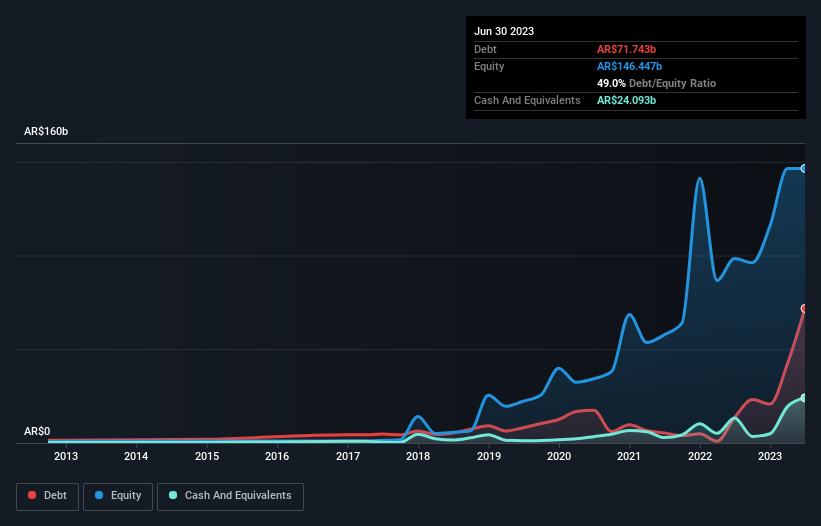- United States
- /
- Basic Materials
- /
- NYSE:LOMA
Loma Negra Compañía Industrial Argentina Sociedad Anónima (NYSE:LOMA) Takes On Some Risk With Its Use Of Debt

Legendary fund manager Li Lu (who Charlie Munger backed) once said, 'The biggest investment risk is not the volatility of prices, but whether you will suffer a permanent loss of capital.' It's only natural to consider a company's balance sheet when you examine how risky it is, since debt is often involved when a business collapses. We can see that Loma Negra Compañía Industrial Argentina Sociedad Anónima (NYSE:LOMA) does use debt in its business. But is this debt a concern to shareholders?
When Is Debt Dangerous?
Debt and other liabilities become risky for a business when it cannot easily fulfill those obligations, either with free cash flow or by raising capital at an attractive price. Ultimately, if the company can't fulfill its legal obligations to repay debt, shareholders could walk away with nothing. While that is not too common, we often do see indebted companies permanently diluting shareholders because lenders force them to raise capital at a distressed price. Of course, the upside of debt is that it often represents cheap capital, especially when it replaces dilution in a company with the ability to reinvest at high rates of return. The first step when considering a company's debt levels is to consider its cash and debt together.
See our latest analysis for Loma Negra Compañía Industrial Argentina Sociedad Anónima
What Is Loma Negra Compañía Industrial Argentina Sociedad Anónima's Net Debt?
You can click the graphic below for the historical numbers, but it shows that as of June 2023 Loma Negra Compañía Industrial Argentina Sociedad Anónima had AR$71.7b of debt, an increase on AR$13.6b, over one year. However, it also had AR$24.1b in cash, and so its net debt is AR$47.7b.

How Healthy Is Loma Negra Compañía Industrial Argentina Sociedad Anónima's Balance Sheet?
Zooming in on the latest balance sheet data, we can see that Loma Negra Compañía Industrial Argentina Sociedad Anónima had liabilities of AR$70.5b due within 12 months and liabilities of AR$102.3b due beyond that. Offsetting these obligations, it had cash of AR$24.1b as well as receivables valued at AR$16.3b due within 12 months. So its liabilities total AR$132.5b more than the combination of its cash and short-term receivables.
This deficit isn't so bad because Loma Negra Compañía Industrial Argentina Sociedad Anónima is worth AR$245.0b, and thus could probably raise enough capital to shore up its balance sheet, if the need arose. But it's clear that we should definitely closely examine whether it can manage its debt without dilution.
In order to size up a company's debt relative to its earnings, we calculate its net debt divided by its earnings before interest, tax, depreciation, and amortization (EBITDA) and its earnings before interest and tax (EBIT) divided by its interest expense (its interest cover). The advantage of this approach is that we take into account both the absolute quantum of debt (with net debt to EBITDA) and the actual interest expenses associated with that debt (with its interest cover ratio).
Even though Loma Negra Compañía Industrial Argentina Sociedad Anónima's debt is only 1.6, its interest cover is really very low at 1.2. This does suggest the company is paying fairly high interest rates. In any case, it's safe to say the company has meaningful debt. Importantly, Loma Negra Compañía Industrial Argentina Sociedad Anónima's EBIT fell a jaw-dropping 50% in the last twelve months. If that decline continues then paying off debt will be harder than selling foie gras at a vegan convention. There's no doubt that we learn most about debt from the balance sheet. But ultimately the future profitability of the business will decide if Loma Negra Compañía Industrial Argentina Sociedad Anónima can strengthen its balance sheet over time. So if you want to see what the professionals think, you might find this free report on analyst profit forecasts to be interesting.
Finally, a company can only pay off debt with cold hard cash, not accounting profits. So it's worth checking how much of that EBIT is backed by free cash flow. During the last three years, Loma Negra Compañía Industrial Argentina Sociedad Anónima produced sturdy free cash flow equating to 68% of its EBIT, about what we'd expect. This cold hard cash means it can reduce its debt when it wants to.
Our View
On the face of it, Loma Negra Compañía Industrial Argentina Sociedad Anónima's interest cover left us tentative about the stock, and its EBIT growth rate was no more enticing than the one empty restaurant on the busiest night of the year. But on the bright side, its conversion of EBIT to free cash flow is a good sign, and makes us more optimistic. Looking at the balance sheet and taking into account all these factors, we do believe that debt is making Loma Negra Compañía Industrial Argentina Sociedad Anónima stock a bit risky. That's not necessarily a bad thing, but we'd generally feel more comfortable with less leverage. When analysing debt levels, the balance sheet is the obvious place to start. But ultimately, every company can contain risks that exist outside of the balance sheet. Be aware that Loma Negra Compañía Industrial Argentina Sociedad Anónima is showing 1 warning sign in our investment analysis , you should know about...
At the end of the day, it's often better to focus on companies that are free from net debt. You can access our special list of such companies (all with a track record of profit growth). It's free.
New: AI Stock Screener & Alerts
Our new AI Stock Screener scans the market every day to uncover opportunities.
• Dividend Powerhouses (3%+ Yield)
• Undervalued Small Caps with Insider Buying
• High growth Tech and AI Companies
Or build your own from over 50 metrics.
Have feedback on this article? Concerned about the content? Get in touch with us directly. Alternatively, email editorial-team (at) simplywallst.com.
This article by Simply Wall St is general in nature. We provide commentary based on historical data and analyst forecasts only using an unbiased methodology and our articles are not intended to be financial advice. It does not constitute a recommendation to buy or sell any stock, and does not take account of your objectives, or your financial situation. We aim to bring you long-term focused analysis driven by fundamental data. Note that our analysis may not factor in the latest price-sensitive company announcements or qualitative material. Simply Wall St has no position in any stocks mentioned.
About NYSE:LOMA
Loma Negra Compañía Industrial Argentina Sociedad Anónima
Manufactures and sells cement and its derivatives in Argentina.
Adequate balance sheet with acceptable track record.
Similar Companies
Market Insights
Community Narratives




